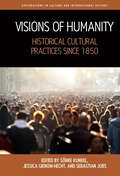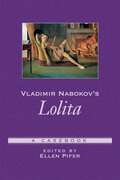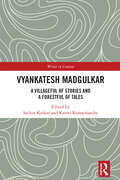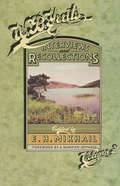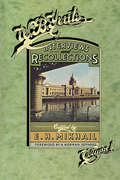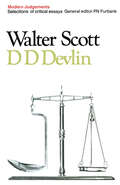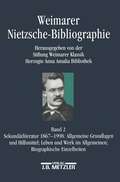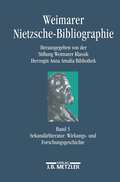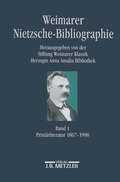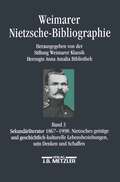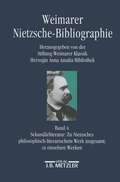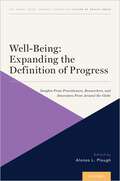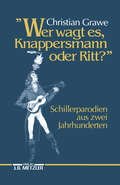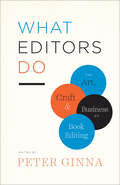- Table View
- List View
Virginia Woolf, Europe, and Peace: Vol. 2 Aesthetics and Theory (Clemson University Press)
From the “prying,” “insidious” “fingers of the European War” that Septimus Warren Smith would never be free of in Mrs Dalloway to the call to “think peace into existence” during the Blitz in “Thoughts on Peace in an Air Raid,” questions of war and peace pervade the writings of Virginia Woolf. This volume asks how Woolf conceptualised peace by exploring the various experimental forms she created in response to war and violence. Comprised of fifteen chapters by an international array of leading and emerging scholars, this book both draws out theoretical dimensions of Woolf’s modernist aesthetic and draws on various critical frameworks for reading her work, in order to deepen our understanding of her writing about the politics of war, ethics, feminism, class, animality, and European culture. The chapters collected here look at how we might re-read Woolf and her contemporaries in the light of new theoretical and aesthetical innovations, such as peace studies, post-critique, queer theory, and animal studies. It also asks how we might historicise these frameworks through Woolf’s own engagement with the First and Second World Wars, while also bringing her writings on peace into dialogue with those of others in the Bloomsbury Group. In doing so, this volume reassesses the role of Europe and peace in Woolf’s work and opens up new ways of reading her oeuvre.
Virginia Woolf, Europe, and Peace: Vol. 1 Transnational Circulations (Clemson University Press)
Virginia Woolf, Europe, and Peace: Transnational Circulations enlarges our understanding of Virginia Woolf’s pacifist ideology and aesthetic response to the World Wars by re-examining her writings and cultural contexts transnationally and comparatively through the complex interplay between modernism, politics, and aesthetics. The “transnational” paradigm that undergirds this collection revolves around the idea of transnational cultural communities of writers, artists, and musicians worldwide who were intellectually involved in the war effort through the forging of pacifist cultural networks that arose as a form of resistance to war, militarism, and the rise of fascism. The book also offers philosophical approaches to notions of transnational pacifism, anti-war ethics, and decolonization, examining how Woolf’s prose undermines center/edge or self/other bifurcations. Breathing new life into Woolf’s anti-war writings through a transnational lens and presenting us with the voices and perspectives of a range of significant scholars and critics, the chapters in this volume engage with mobile and circulatory pacifisms, calling attention to the intersections of modernist inquiries across the arts (art, music, literature, and performance) and transnational critical spaces (Asia, Europe, and the Americas) to show how the convergence of different cultural and linguistic horizons can significantly expand and enrich our understanding of Woolf’s modernist legacy.
Virtual English as a Lingua Franca (Routledge Studies in Applied Linguistics)
This collection offers a comprehensive account of the development of intercultural communication strategies through Virtual English as a lingua franca, reflecting on the ways in which we make pragmatic meaning in today’s technology-informed globalized world. The volume places an emphasis on analyzing transmodal, trans-semiotic, and transcultural discourse practices in online spaces, providing a counterpoint to existing ELF research which has leaned towards unpacking formal features of ELF communication in face-to-face interactions. The chapters explore how these practices are characterized and then further sustained via non-verbal semiotic resources, drawing on data from a global range of empirical studies. The book prompts further reflection on readers’ own experiences in online settings and the challenges of VELF while also supplying educators in these contexts with the analytical resources to better bridge the gap between formal and informal learning. Highlighting the dynamic complexity of online intercultural communication in the twenty-first century, this book is a valuable resource for students and scholars in applied linguistics, language education, digital communication, and intercultural communication.
Visions of Humanity: Historical Cultural Practices since 1850 (Explorations in Culture and International History #11)
This book offers a critical reflection of the historical genesis, transformation, and problématique of “humanity” in the transatlantic world, with a particular eye on cultural representations. “Humanity,” the essays show, was consistently embedded in networks of actors and cultural practices, and its meanings have evolved in step with historical processes such as globalization, cultural imperialism, the transnationalization of activism, and the spread of racism and nationalism. Visions of Humanity applies a historical lens on objects, sounds, and actors to provide a more nuanced understanding of the historical tensions and struggles involved in constructing, invoking, and instrumentalizing the “we” of humanity.
Vladimir Nabokov's Lolita: A Casebook (Casebooks in Criticism)
Midway through the last century, Lolita burst on the literary scene--a Russian exile's extraordinary gift to American letters and the New World. The scandal provoked by the novel's subject--the sexual passion of a middle-aged European for a twelve-year-old American girl--was quickly upstaged by the critical attention it received from readers, scholars, and critics around the world. This casebook gathers together an interview with Nabokov as well as nine critical essays about Lolita. The essays follow a progression focusing first on textual and thematic features and then proceeding to broader topics and cultural implications, including the novel's relations to other works of literature and art and the movies adapted from it.
Vocabularies of Public Life: Empirical Essays in Symbolic Structure (Routledge Revivals)
First published in 1992, Vocabularies of Public Life explores the revolution that has taken place in our understanding of contemporary culture and decodes a number of the symbols which now dominate public life. Wuthnow divides the essays collected here into three distinct ‘vocabularies.’ Part I examines the ways in which religious and scientific languages function as vocabularies of conviction in public life, Part II focuses on music and art as vocabularies of expression, and Part III considers law, ideology, and public policy as vocabularies of persuasion. The contributors discuss such diverse subjects as American spiritualism, the syntax of modern dance and the social contexts of number one songs. What unifies the book is the common concern with the concrete, everyday manifestations of culture and the importance of understanding its basic structure. This book will be of interest to specialists and scholars of various disciplines such as linguistics, literature, media studies, popular culture, and sociology.
Vom Salon zur Barrikade: Frauen der Heine-Zeit (Heine Studien)
Porträts von 25 Frauen aus der ersten Hälfte des 19. Jahrhunderts. Der Band gibt einen Einblick in die Spannweite weiblicher Aktivitäten - von der Sängerin bis zur Ärztin, von der Komponistin bis zur Frauenrechtlerin. Mit Beiträgen über: Rahel Varnhagen, Caroline Fouqué, Lea Mendelssohn, Jeanette Strauß-Wohl, Rosa Maria Assing, Anna Milder, Wilhelmine Schröder-Devrient, Amalie Schoppe, Friederike Robert, Adele Schopenhauer, Therese von Jacob, Louise Henry, Charlotte Birch-Pfeiffer, Kathinka Zitz-Halein, Fanny Hensel, Charlotte Stieglitz, Louise Dittmar, Marie von Colomb, Johanna Kinkel, Marie Norden, Roswitha Kind, Bertha Traun-Ronge, Louise Otto-Peters, Helena Demuth, Emile von Hallberg.
Vyankatesh Madgulkar: A Villageful of Stories and a Forestful of Tales (Writer in Context)
Vyankatesh Madgulkar (1927–2001) was one of the pioneers of modernist short fiction (nav katha) as well as ‘rural’ (grameen) fiction in Marathi in the post-World War II era. He wrote eight novels, two hundred short stories, several plays, including some notable ‘folk plays’ (loknatya), screenplays and dialogues for more than eighty Marathi films. This book offers a comprehensive understanding of Vyankatesh Madgulkar’s work by analysing selections from his major creative fictions and nonfictions. This is augmented with important writings on him by his contemporaries, as well as critical writings, commentaries and reviews by present-day scholars. It situates Madgulkar in the context of Marathi literary tradition and Indian literature in general.Part of the Writer in Context series, this book will be useful for scholars and researchers of Indian literature, Marathi literature, English literature, comparative literature, postcolonial studies, cultural studies, global south studies and translation studies.
Wallace Stevens In Theory (Liverpool English Texts and Studies #101)
The modernist poetry of Wallace Stevens is replete with moments of theorizing. Stevens regarded poetry as an abstract medium through which to think about and theorize not only philosophical concepts like metaphor and reality, but also a unifying thesis about the nature of poetry itself. At the same time, literary theorists and philosophers have often turned to Stevens as a canonical reference point and influence. In the centenary year of Wallace Stevens’s first collection Harmonium (1923), this collection asks what it means to theorize with Stevens today. Through a range of critical and theoretical perspectives, this book seeks to describe the myriad kinds of thinking sponsored by Stevens’s poetry and explores how contemporary literary theory might be invigorated through readings of Stevens.
Walter Besant: The Business of Literature and the Pleasures of Reform (Liverpool English Texts and Studies #76)
In the 1880s and 1890s, Walter Besant was one of Britain’s most lionized living novelists. Like many popular writers of the period, Besant suffered from years of critical neglect. Yet his centrality to Victorian society and culture all but ensured a revival of interest. While literary critics are now rediscovering the more than forty works of fiction that he penned or co-wrote, as part of a more general revaluation of Victorian popular literature, legal scholars have argued that Besant, by advocating for copyright reform, played a crucial role in consolidating a notion of literary property as the exclusive possession of the individuated intellect. For their part, historians have recently shown how Besant – as a prominent philanthropist who campaigned for the cultural vitalization of impoverished areas in east and south London – galvanized late Victorian social reform activities. The expanding corpus of work on Besant, however, has largely kept the domains of authorship and activism, which he perceived as interrelated, conceptually distinct. Analysing the mutually constitutive interplay in Besant’s career between philanthropy and the professionalization of authorship, Walter Besant: The Business of Literature and the Pleasures of Reform highlights their fundamental interconnectedness in this Victorian intellectual polymath’s life and work.
Walter de la Mare: Critical Appraisals (Liverpool English Texts and Studies #95)
This book aims to put Walter de la Mare back on the literary map. A writer beloved by many, he has nevertheless remained on the sidelines of literary history. Walter de la Mare: Critical Appraisals promises to restore his reputation as one of the most memorably haunting of poets, as well as a peculiarly unnerving writer of ghost stories. A collection of varied, wide-ranging essays on de la Mare’s poetry, stories, novels, reviews and lectures, it puts his work beside that of many of his famous contemporaries, including Thomas Hardy, Robert Frost, W. H. Auden, T. S. Eliot and Katherine Mansfield. It also contains an invaluable survey of his archive, much of it unpublished, and a number of newly commissioned poems reflecting on his legacy. This multifaceted volume will be of interest to students working on twentieth-century poetry, the short story, the nature and limits of modernism and British intellectual history, as well as on de la Mare himself.List of contributors: Catherine Charlwood, Guy Cuthbertson, Peter Davidson, Giles de la Mare, Andrew Doyle, Suzannah V. Evans, Adam Guy, Robin Holloway, Yui Kajita, Zaffar Kunial, Gregory Leadbetter, Angela Leighton, Erica McAlpine, Jenny McDonnell, Will May, Andrew Motion, Paul Muldoon, A. J. Nickerson, Seamus Perry, Adrian Poole, Camille Ralphs, Vidyan Ravinthiran, Peter Scupham, A. E. Stallings, Mark Valentine, Rory Waterman, Anne Welsh, David Wheatley, Rowan Williams, William Wootten.
Walter Höllerer: Poetologische und literaturgeschichtliche Schriften 1952–1986
Walter Höllerer (1922–2003) gestaltete als Mitglied der Gruppe 47 und langjähriger Mitherausgeber der Zeitschrift Akzente maßgeblich die Modernisierung der deutschen Literatur in der zweiten Hälfte des 20. Jahrhunderts. Er gründete das Institut und die Zeitschrift Sprache im technischen Zeitalter sowie das Literarische Colloquium Berlin, gab wegweisende Anthologien wie Transit oder Junge amerikanische Lyrik heraus und organisierte Veranstaltungen, die den modernen Literaturbetrieb prägten. Seinen Schriften lassen sich zentrale Veränderungen des Literaturbegriffs im Übergang von der Nachkriegs- zur Gegenwartsliteratur ablesen. Anlässlich seines 100. Geburtstages und 20. Todestages präsentiert die Edition eine Auswahl der poetologischen und literaturgeschichtlichen Texte Walter Höllerers.
Weimarer Nietzsche-Bibliographie in 5 Bänden: Band 2: Sekundärliteratur 1867-1998: Allgemeine Grundlagen und Hilfsmittel; Leben und Werke im Allgemeinen; Biographische Einzelheiten
Die Weimarer Nietzsche-Bibliographie erfasst die zwischen 1867 und 1998 erschienene Primär- und Sekundärliteratur aller Sprachen und Länder. Ziel ist es, ein zuverlässiges bibliographisches Grundlagenwerk zu Leben, Werk und Wirkung Nietzsches für die internationale Einzelforschung und darüber hinaus für die Geisteswissenschaften insgesamt zu schaffen. Angestrebt wird ein hoher Grad an Vollständigkeit. Bei der Verzeichnung der Sekundärliteratur wird neben der eigentlichen Forschungsliteratur besonderes Augenmerk auf die Literatur zur Wirkungsgeschichte gelegt. Die Titelbeschreibung erfolgt weitgehend aufgrund der vorliegenden Originalquelle. An der Herzogin Anna Amalia Bibliothek ist mit der Privatbibliothek Friedrich Nietzsches und mit der Bibliothek des Nietzsche-Archivs, das bis 1945 seine Wirkungsstätte in Weimar hatte, ein Grundbestand der Nietzsche-Literatur vorhanden, der seit 1990 systematisch ausgebaut wird. Auf diesem Bestand konnte das Projekt einer umfassenden retrospektiven Personalbibliographie zu Friedrich Nietzsche aufbauen. Die Bibliographie erschließt die Literatur systematisch über Annotationen sowie über Register (Personen-, Sach- und Werkregister). Das Werk erscheint in fünf Bänden. Band 1 liegt bereits vor. Die übrigen vier Bände mit der Forschungsliteratur und der Literatur zur Wirkungsgeschichte folgen im April 2002. Insgesamt werden über 20.000 Dokumente verzeichnet. Die Weimarer Nietzsche-Bibliographie bildet die Plattform für jede Beschäftigung mit der internationalen Wirkung Nietzsches.
Weimarer Nietzsche-Bibliographie in 5 Bänden: Band 5: Sekundärliteratur: Wirkungs- und Forschungsgeschichte
Die Weimarer Nietzsche-Bibliographie erfasst die zwischen 1867 und 1998 erschienene Primär- und Sekundärliteratur aller Sprachen und Länder. Ziel ist es, ein zuverlässiges bibliographisches Grundlagenwerk zu Leben, Werk und Wirkung Nietzsches für die internationale Einzelforschung und darüber hinaus für die Geisteswissenschaften insgesamt zu schaffen. Angestrebt wird ein hoher Grad an Vollständigkeit. Bei der Verzeichnung der Sekundärliteratur wird neben der eigentlichen Forschungsliteratur besonderes Augenmerk auf die Literatur zur Wirkungsgeschichte gelegt. Die Titelbeschreibung erfolgt weitgehend aufgrund der vorliegenden Originalquelle. An der Herzogin Anna Amalia Bibliothek ist mit der Privatbibliothek Friedrich Nietzsches und mit der Bibliothek des Nietzsche-Archivs, das bis 1945 seine Wirkungsstätte in Weimar hatte, ein Grundbestand der Nietzsche-Literatur vorhanden, der seit 1990 systematisch ausgebaut wird. Auf diesem Bestand konnte das Projekt einer umfassenden retrospektiven Personalbibliographie zu Friedrich Nietzsche aufbauen. Die Bibliographie erschließt die Literatur systematisch über Annotationen sowie über Register (Personen-, Sach- und Werkregister). Das Werk erscheint in fünf Bänden. Band 1 liegt bereits vor. Die übrigen vier Bände mit der Forschungsliteratur und der Literatur zur Wirkungsgeschichte folgen im April 2002. Insgesamt werden über 20.000 Dokumente verzeichnet. Die Weimarer Nietzsche-Bibliographie bildet die Plattform für jede Beschäftigung mit der internationalen Wirkung Nietzsches.
Weimarer Nietzsche-Bibliographie in 5 Bänden: Band 1: Primärliteratur 1867-1998
Die Weimarer Nietzsche-Bibliographie erfasst die zwischen 1867 und 1998 erschienene Primär- und Sekundärliteratur aller Sprachen und Länder. Ziel ist es, ein zuverlässiges bibliographisches Grundlagenwerk zu Leben, Werk und Wirkung Nietzsches für die internationale Einzelforschung und darüber hinaus für die Geisteswissenschaften insgesamt zu schaffen. Angestrebt wird ein hoher Grad an Vollständigkeit. Bei der Verzeichnung der Sekundärliteratur wird neben der eigentlichen Forschungsliteratur besonderes Augenmerk auf die Literatur zur Wirkungsgeschichte gelegt. Die Titelbeschreibung erfolgt weitgehend aufgrund der vorliegenden Originalquelle. An der Herzogin Anna Amalia Bibliothek ist mit der Privatbibliothek Friedrich Nietzsches und mit der Bibliothek des Nietzsche-Archivs, das bis 1945 seine Wirkungsstätte in Weimar hatte, ein Grundbestand der Nietzsche-Literatur vorhanden, der seit 1990 systematisch ausgebaut wird. Auf diesem Bestand konnte das Projekt einer umfassenden retrospektiven Personalbibliographie zu Friedrich Nietzsche aufbauen. Die Bibliographie erschließt die Literatur systematisch über Annotationen sowie über Register (Personen-, Sach- und Werkregister). Das Werk erscheint in fünf Bänden. Band 1 liegt bereits vor. Die übrigen vier Bände mit der Forschungsliteratur und der Literatur zur Wirkungsgeschichte folgen im April 2002. Insgesamt werden über 20.000 Dokumente verzeichnet. Die Weimarer Nietzsche-Bibliographie bildet die Plattform für jede Beschäftigung mit der internationalen Wirkung Nietzsches.
Weimarer Nietzsche-Bibliographie in 5 Bänden: Band 3: Sekundärliteratur 1867-1998: Nietzsches geistige und geschichtskulturelle Lebensbeziehung, sein Denken und Schaffen
Die Weimarer Nietzsche-Bibliographie erfasst die zwischen 1867 und 1998 erschienene Primär- und Sekundärliteratur aller Sprachen und Länder. Ziel ist es, ein zuverlässiges bibliographisches Grundlagenwerk zu Leben, Werk und Wirkung Nietzsches für die internationale Einzelforschung und darüber hinaus für die Geisteswissenschaften insgesamt zu schaffen. Angestrebt wird ein hoher Grad an Vollständigkeit. Bei der Verzeichnung der Sekundärliteratur wird neben der eigentlichen Forschungsliteratur besonderes Augenmerk auf die Literatur zur Wirkungsgeschichte gelegt. Die Titelbeschreibung erfolgt weitgehend aufgrund der vorliegenden Originalquelle. An der Herzogin Anna Amalia Bibliothek ist mit der Privatbibliothek Friedrich Nietzsches und mit der Bibliothek des Nietzsche-Archivs, das bis 1945 seine Wirkungsstätte in Weimar hatte, ein Grundbestand der Nietzsche-Literatur vorhanden, der seit 1990 systematisch ausgebaut wird. Auf diesem Bestand konnte das Projekt einer umfassenden retrospektiven Personalbibliographie zu Friedrich Nietzsche aufbauen. Die Bibliographie erschließt die Literatur systematisch über Annotationen sowie über Register (Personen-, Sach- und Werkregister). Das Werk erscheint in fünf Bänden. Band 1 liegt bereits vor. Die übrigen vier Bände mit der Forschungsliteratur und der Literatur zur Wirkungsgeschichte folgen im April 2002. Insgesamt werden über 20.000 Dokumente verzeichnet. Die Weimarer Nietzsche-Bibliographie bildet die Plattform für jede Beschäftigung mit der internationalen Wirkung Nietzsches.
Weimarer Nietzsche-Bibliographie in 5 Bänden: Band 4: Sekundärliteratur: Zu Nietzsches philosophisch-literarischem Werk insgesamt; zu einzelnen Werken
Die Weimarer Nietzsche-Bibliographie erfasst die zwischen 1867 und 1998 erschienene Primär- und Sekundärliteratur aller Sprachen und Länder. Ziel ist es, ein zuverlässiges bibliographisches Grundlagenwerk zu Leben, Werk und Wirkung Nietzsches für die internationale Einzelforschung und darüber hinaus für die Geisteswissenschaften insgesamt zu schaffen. Angestrebt wird ein hoher Grad an Vollständigkeit. Bei der Verzeichnung der Sekundärliteratur wird neben der eigentlichen Forschungsliteratur besonderes Augenmerk auf die Literatur zur Wirkungsgeschichte gelegt. Die Titelbeschreibung erfolgt weitgehend aufgrund der vorliegenden Originalquelle. An der Herzogin Anna Amalia Bibliothek ist mit der Privatbibliothek Friedrich Nietzsches und mit der Bibliothek des Nietzsche-Archivs, das bis 1945 seine Wirkungsstätte in Weimar hatte, ein Grundbestand der Nietzsche-Literatur vorhanden, der seit 1990 systematisch ausgebaut wird. Auf diesem Bestand konnte das Projekt einer umfassenden retrospektiven Personalbibliographie zu Friedrich Nietzsche aufbauen. Die Bibliographie erschließt die Literatur systematisch über Annotationen sowie über Register (Personen-, Sach- und Werkregister). Das Werk erscheint in fünf Bänden. Band 1 liegt bereits vor. Die übrigen vier Bände mit der Forschungsliteratur und der Literatur zur Wirkungsgeschichte folgen im April 2002. Insgesamt werden über 20.000 Dokumente verzeichnet. Die Weimarer Nietzsche-Bibliographie bildet die Plattform für jede Beschäftigung mit der internationalen Wirkung Nietzsches.
Well-Being: Insights From Practitioners, Researchers, and Innovators From Around the Globe (Culture of Health)
Cities and countries around the world, from New Zealand to Singapore to Iceland, are starting to take a well-being approach by reorienting policies, budgets and other actions to advance human and planetary well-being. Well-being metrics--holistic measurements of an individual's or population's capacity to thrive, including the condition of their community, society, and environment--provide a nuanced and predictive view that transcends purely economic measures; they illuminate conditions of inequity and despair that other tools ignore, and expand the notion of health beyond simply the absence of disease. Well-Being: Expanding the Definition of Progress summarizes the experiences and insights of practitioners, researchers and innovators from around the world, gathered together by the Robert Wood Johnson Foundation to explore how a well-being approach might further spread in the United States. Centered in the commitment to balance economic growth--the traditional dashboard of progress--with well-being, this book is a combination of scientific papers, case studies from the field, and excerpts from a lively, multidisciplinary discussion which intentionally connects issues of measurement to the imperative for action. Rich with insights on policy and practice, narratives and culture, equity and shifts in power, alignment with other movements, and cross-sector collaboration, it is intended to inspire governmental leaders, policymakers, economists, measurement scientists, reporters, and others who crave a more integrated and balanced pursuit of progress.
"Wer wagt es, Knappersmann oder Ritt?": Schiller-Parodien aus zwei Jahrhunderten
70 Schillerparodien von 1789 bis zur Gegenwart, unter den Parodisten so bekannte Namen wie August Wilhelm Schlegel, Carl Maria von Weber, Heinrich Heine, Adolf Glaßbrenner, Robert Walser und Thorsten Becker: ein diebisches Lesevergnügen.
What Editors Do: The Art, Craft, and Business of Book Editing (Chicago Guides to Writing, Editing, and Publishing)
Editing is an invisible art where the very best work goes undetected. Editors strive to create books that are enlightening, seamless, and pleasurable to read, all while giving credit to the author. This makes it all the more difficult to truly understand the range of roles they inhabit while shepherding a project from concept to publication. In What Editors Do, Peter Ginna gathers essays from twenty-seven leading figures in book publishing about their work. Representing both large houses and small, and encompassing trade, textbook, academic, and children’s publishing, the contributors make the case for why editing remains a vital function to writers—and readers—everywhere. Ironically for an industry built on words, there has been a scarcity of written guidance on how to actually approach the work of editing. This book will serve as a compendium of professional advice and will be a resource both for those entering the profession (or already in it) and for those outside publishing who seek an understanding of it. It sheds light on how editors acquire books, what constitutes a strong author-editor relationship, and the editor’s vital role at each stage of the publishing process—a role that extends far beyond marking up the author’s text. This collection treats editing as both art and craft, and also as a career. It explores how editors balance passion against the economic realities of publishing. What Editors Do shows why, in the face of a rapidly changing publishing landscape, editors are more important than ever.
What Forms Can Do: The Work of Form in 20th- and 21st- Century French Literature and Thought (Contemporary French and Francophone Cultures #69)
This volume responds to important questions about the formal properties of literary texts and the agency of form. A central feature of twentieth- and twenty-first century French and Francophone writing has been the exploration of how cultural forms (literary, philosophical and visual) create distinctive semiotic environments and at the same time engage powerfully with external realities. How does form propose a bridge between the environment of the text and the world beyond? What kinds of formal innovations have authors devised in response to the complexity of that world? How do the formal properties of texts inflect our reading of them, and perhaps also our apprehension of the real? In addressing such questions as they apply to a wide corpus of texts, including the novel, life writing, the essay, travel writing, poetry and textual/visual experiments, the chapters in this volume offer new perspectives on a wide range of creative figures including Proust, Picasso, Breton, Bataille, Ponge, Guillevic, Certeau, Camus, Barthes, Perec, Roubaud, Chauvet, Savitzkaya, Eribon, Ernaux, Laurens and Akerman. Collectively, they renew the engagement with form that has been a key feature of French cultural production and of analysis in French studies.



